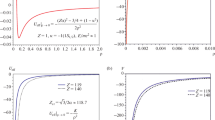Abstract
We consider a method for deriving relativistic two-body wave equations for fermions in the coordinate representation. The Lagrangian of the theory is reformulated by eliminating the mediating fields by means of covariant Green's functions. Then, the nonlocal interaction terms in the Lagrangian are reduced to local expressions which take into account retardation effects approximately. We construct the Hamiltonian and two-fermion states of the quantized theory, employing an unconventional “empty” vacuum state, and derive relativistic two-fermion wave equations. These equations are a generalization of the Breit equation for systems with scalar, pseudoscalar, vector, pseudovector and tensor coupling.
Similar content being viewed by others
References
M. Barham and J.W. Darewych: “Exact two-body eigenstates in scalar quantum field theory”, Journal of Physic A, Vol. 31, (1998), pp. 3481–3491.
J.W. Darewych and L. Di Leo: “Two-fermion Dirac-like eigenstates of the Coulomb QED Hamiltonian”, Journal of Physic A, Vol. 29, (1996), pp. 6817–6841.
J.W. Darewych: “Few-particle eigenstates in the Yukawa model”, Condensed Matter Physics, Vol. 1, (1998), pp. 593–604.
J.W. Darewych and A. Duviryak: “Exact few-particle eigenstates in partially reduced QED”, Physical Review A, Vol. 66, (2002), pp. 032102
G.V. Efimov: “Nonlocal quantum field theory and particle physics”, In: I.A. Batalin et al (Eds.):Quantum Field Theory and Quantum Statistics. Essays in honour of the sixtieth birthday of E.S. Fradkin, Adam Hilger, Bristol, pp. 545–564; G.V. Efimov:Problems of Quantum Theory of Nonlocal Interactions, Nauka, Moscow, 1985 (in Russian).
J. Kiskis: “Modified field theory for quark binding”, Physical Review D, Vol. 11, (1975), pp. 2178–2202.
S. Blaha: “Embedding classical fields in quantum field theories”, Physical Review D, Vol. 17, (1978), pp. 994–1008.
L.L. Jenkovszky, F. Paccanoni and Z.E. Chikovani: “Gluon exchange in elastic hadron scattering”, Yadernaya Fizika, Vol. 53, (1991), pp. 526–538;Soviet Journal of Nuclear Physics, Vol. 53, (1991), pp. 329–336.
E.H. Kerner (Ed.):The Theory of Action-at-a-Distance in Relativistic Particle Mechanics, Collection of reprints, Gordon and Breach, New York, 1972.
P. Havas: “Galilei- and Lorentz-invariant particle systems and their conservation laws”, In: M. Bunge (Ed.).Problems in the Foundations of Physics, Springer, Berlin, 1971, pp. 31–48.
F. Hoyle and J.V. Narlicar:Action-at-a-Distance in Physics and Cosmology, Freeman and Co, San-Francisco, 1974.
V.N. Golubenkov and Ia.A. Smorodinskii: “Lagrangian function for the system of identical charged particles”, Zh. Eksp. Teor. Fiz., Vol. 31, (1956), p. 330;Soviet Physics. JETP, Vol. 4, (1957), p. 55.
L.D. Landau and E.M. Lifshitz:The Classical Theory of Fields, 4th rev. ed., Pergamon, New York, 1975.
B.M. Barker and R.F. O'Connell: “Acceleration-dependent lagrangians and equations of motion”, Physics Letters A, Vol. 78, (1980), pp. 231–232.
B.M. Barker and R.F. O'Connell: “The post-post-Newtonian problem in classical electromagnetic theory”, Annals of Physics, NY, Vol. 129, (1980), pp. 358–377.
G. Schäfer: “Acceleration-dependent lagrangians in general relativity”, Physics Letters A, Vol. 100, (1984), pp. 128–129.
B.M. Barker and R.F. O'Connell: “Removal of acceleration terms from the two-body Lagrangian to orderc −4 in electromagnetic theory”, Canadian J. Phys., Vol. 58, (1980), pp. 1659–1666.
R.P. Gaida, Yu.B. Kluchkovsky and V.I. Tretyak: “Three-dimensional Lagrangian approach to the classical relativistic dynamics of directly interacting particles”, In: G. Longhi and L. Lusanna (Eds.):Constraint's Theory and Relativistic Dynamics, Florence (Italy), 1986, World Scientific Publishing Co, Singapore, 1987, pp. 210–241.
R.W. Childers: “Effective Hamiltonians for generalized Breit interactions in QCD”, Physical Review D, Vol. 36, (1987), pp. 606–614.
G. Breit: “The effect of retardation on the interaction of two electrons”, Physical Review, Vol. 34, (1929), pp. 553–573.
P. Van Alstine and H.W. Crater: “A tale of three equations: Breit, Eddington-Gaunt, and two-body Dirac”, Foundations of Physics, Vol. 27, (1997), pp. 67–79.
G.D. Tsibidis: “Quark-Antiquark Bound States and the Breit Equation”, LANL e-Print archive (2000), http://xxx.lanl.gov/abs/hep-ph/0007143.
D.D. Brayshaw: “Relativistic description of quarkonium”, Physical Review D, Vol. 36, (1987), pp. 1465–1478.
I.V. Simenog and A.I. Turovsky: “A relativistic model of the two-nucleon problem with direct interaction”, Ukraïn. Fiz. Zh., Vol. 46, (2001), pp. 391–401 (in Ukrainian); I.V. Simenog and A.I. Turovsky: “The model of deuteron in Dirac-Breit approach with direct interaction”, Journal of Physical Studies, Vol. 8, (2004), pp. 23–34 (in Ukrainian).
A.A. Khelashvili: “Radial quasipotential equation for a fermion and antifermion and infinitely rising central potentials”, Teoreticheskaya i Matematicheskaya Fizika, Vol. 51, (1982), pp. 201–210;Theoretical and Mathematical Physics, Vol. 51, (1982), pp. 447–453.
H.W. Crater, C.W. Wong and C.-Y. Wong: “Singularity-free Breit equation from constraint two-body Dirac equations”, International Journal of Modern Physics E, Vol. 5, (1996), pp. 589–615.
O. Mustafa and T. Barakat: “Nonrelativistic shifted-l expansion technique for three-and two-dimensional Schrödinger equation”, Communications in Theoretical Physics, Vol. 28, (1997), pp. 257–264; O. Mustafa and T. Barakat: “Relativistic shifted-l expansion technique for Dirac and Klein-Gordon equations”, Communications in Theoretical Physics, Vol. 29, (1998), pp. 587–594.
Author information
Authors and Affiliations
About this article
Cite this article
Duviryak, A., Darewych, J.W. Variational wave equations of two fermions interacting via scalar, pseudoscalar, vector, pseudovector and tensor fields. centr.eur.j.phys. 3, 467–483 (2005). https://doi.org/10.2478/BF02475607
Received:
Accepted:
Issue Date:
DOI: https://doi.org/10.2478/BF02475607
Keywords
- quantum field theory
- two-fermion systems
- relativistic wave equation
- covariant Green function
- retardation effect



